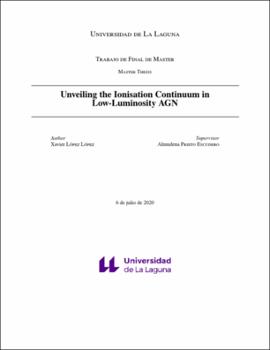Unveiling the Ionisation Continuum in Low-Luminosity AGN
Author
López López, XavierDate
2021Abstract
The accretion disc of low-luminosity active galactic nuclei (LLAGN) is predicted to disappear at
low Eddington ratios (Lbol/Ledd < −3), while high-angular resolution observations of these nuclei have
revealed a steep power law optical/UV continuum with α ∼ 2 (Fν ∼ ν
−α
), characteristic of synchrotron
emission. However, hydrogen absorption makes it impossible to probe this continuum shortwards of
∼ 1000 Å, and thus the possible contribution of an accretion disc cannot be fully discarded. Still, this
information is encoded in the fine structure lines produced by the AGN ionised gas, whose relative
intensities are sensitive to the shape of the ionising continuum and therefore can be used to probe the
presence of the accretion disc. In this work we have combined diffraction-limited high-angular resolution
observations from the Hubble Space Telescope in the optical/UV range and the Very Large Telescope
in the near- to mid-infrared (IR) range for a sample of 10 LLAGN. These direct measurements of the
accessible part of the LLAGN continuum have been combined with photo-ionisation simulations using
Cloudy and mid-IR fine-structure lines observed by Spitzer, to infer the shape of the missing continuum
below ∼ 1000 Å. This approach allowed us to reconstruct the primary ionising spectra and the disc
contribution in prototypical LLAGN nuclei such as M87, NGC 1052, or the Sombrero galaxy. The IR
emission line properties of the LLAGN in our sample can be reproduced by a power law continuum
extending from the UV to the X-ray range, with a typical index of 0.35 . α . 0.55, with a negligible or
no contribution at all from the accretion disc to the ionisation. These accretion discs must be truncated
or in a cool state in order to explain the lack of ionising photons. The power law component dominating
the extreme UV continuum in LLAGN is associated with inverse Compton emission from reprocessed
synchrotron jet emission by the black hole corona. This is supported by photo-ionisation predictions for
jet models applied to three of the LLAGN in our sample.





